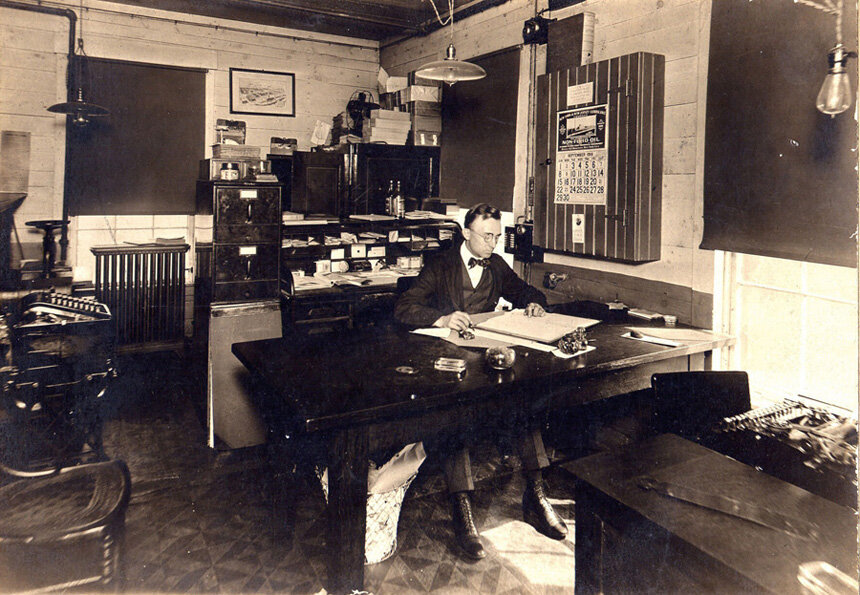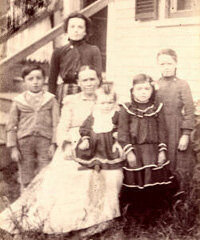
STUDENT ACTIVITES
These stories were written by educator, Chris Lewis, with funding from the Institute of Museum & Library Services.They are loosely based on records of the LaPlante family, who moved from Sainte Perpétue to Franklin about 1903. The images are from the Morin Collection, Belknap Mill.
BE A HISTORY DETECTIVE
This photograph shows Alphonse Morin at the Belknap Mill. Alphonse was a son of the owner, J. P. Morin. What can you tell about Alphonse and his job in this picture?
Divide the photograph into four sections. Look at each section. List what you see in each section.
What kind of job did Alphonse Morin have? Why do you think so?
Name 15 items that you can find in an office today.
How is his office different from an office today? Find seven items that you would not usually find in an office today.
What are the sources of light in this room? How many can you find?
What could Alphonse Morin use to write letters? Why do you think so?
What is missing from this office that you would see in an office today?
Do you think the picture was taken in the summer? Why?
Take a good look at the calendar, located on the wall next to Alphonse. When was this picture taken? If you can't make it out, look at this larger image.
Think about: What kind of worker is Alphonse? Is his office neat or messy? Why do you think so?
Think about: Why was this picture taken? Was it taken for his family or for the company? Why do you think so?
From Montreal to Laconia by Rail
This Activity Page, aimed at Belknap Mill’s younger members, currently tell the story about the Bedard family, who left Saint Perpetué in 1914, to work in the Belknap Mill:
Paul, Angelique and the rest of the Bedard family arrived nearly exhausted in Montreal. It was dinnertime, and they had been riding in the wagon since dawn. They had heard stories from relatives about Montreal, and they were excited to see the big city for the first time, what the city was like. The city was noisy and crowded. Some people were wearing fancy clothes.
Paul and Angelique were the oldest of their six children. They could take only what would fit in their suitcases. They carefully packed their favorite things.
The train station was huge and very beautiful. They walked with all their precious belongings to the Station Master’s window. Father checked for their tickets, the departure track number and time of the next train to Laconia, NH. Mother gathered the six children and settled for the evening in two rows of polished wooden benches near their point of departure - Track Number 6. Mother gave out a dinner of bread and cheese that she had packed earlier in the day. The children savored each bite. They were hungry and tired. Paul and Angelique looked at a train schedule their father had given them. They were disappointed that they would be traveling at night and would be unable to see most of the scenery along the way. They were on their way to America and their new life.
Questions and Activities
What are the two directions the trains ran from Laconia?
Name the seven cities that were destinations.
If you traveled by train on a Sunday from Laconia, where could you go?
What train left Laconia to go north at 8:21 p.m.?
What train left Laconia to go south at 7:05 p.m.?
What do the following words mean: “Express”? “Sleeper”? Today, “Accommodations” mean lodging. In 1915, it meant the opposite of “Express.” Define “Accommodation” in 1915 terms.
Can you read a train schedule?
Here is a copy of a train schedule that was given out at the Laconia Passenger Station in 1915. It tells the kind of train, time of departure, the direction traveling and the destination. It even gives Sunday’s special schedule. To use a train schedule, you need to know this information:
What is your destination?
Are you heading North or South?
What time do you plan to leave Laconia?
What time should you leave home to arrive at the station on time?
You do not want to rush or miss your train.
If the Bedards traveled at night, what kind of railroad car do you think they road in? Why?
If the Bedards left Montreal for their 5-hour trip to Laconia just before midnight, when would they arrive in Laconia so that other passengers could take the train into Boston?
The Truland Brothers Printers at Casino Square in Laconia printed this schedule. What is Casino Square called today? Where is it located?
Where is the train station located in Laconia today? How is it used today?
Bedards move to Laconia
It is 1904 and Paul and Angelique Bedard are moving to Laconia. They live in a farm in the town of St. Perpétue, Québec in Canada. St. Perpétue is 45 miles northeast of Montreal. Paul, Angelique, their parents and 4 other brothers and sisters are moving to Laconia to have a better life.
The Bedard family has no car. They ride a hay wagon 45 miles to Montreal. They ride a train 240 miles from Montreal to Laconia. They walk from the train station to a tenement house.
The Belknap Mill makes socks. Their father Maurice can walk to work. He will work as a boarder. He will put socks on a board in a steam chamber. He will also ring the bell in the mill. He will ring the bell at 6 a.m., noon and 6 p.m. He will work 6 days a week.
At 6 a.m. the next day, Paul and Angelique hear the bell ring. Their father is already at work. At noon, they hear the bell again. Their mother prepares a hot lunch. Paul and Angelique carry their father's lunch in a pail to the Belknap Mill. Soon Paul, Angelique, and 2 other brothers and sisters will also work at the Belknap Mill. Their mother will take care of the younger children.
Questions and Activities
The Bedard Family
What reasons did the Bedards give for going to America?
Cousin Paul wrote about his life in Laconia. How would living in a village or town be different from living in a city?
What was Paul's favorite item? Why were the aprons so important to Angelique?
How many years ago did Paul and Angelique make that trip?
Try this activity. You are moving to a new home. You can take only one suitcase with you. Look around your room. What items would you take? Fill the suitcase below with your choices. Draw or list the items in the suitcase. How are your choices different from Paul's and Angelique's? Why?
A NEW JOB
The Bedard family arrived at the train station in Laconia, tired from their long trip from Quebéc. They were excited to start a new life in New Hampshire. Mrs. Bedard's cousin Pierre met them at the train. He asked Mr. Bedard (Maurice) to go to work with him. The Mill needed many workers. Maurice said he would first help his family move into their new home. He would begin work at the Mill the next day.
Early the next morning, the Mill's bell rang loudly to signal the start of the work day. Maurice and Pierre walked together to the Mill. The Mill owner greeted them in French. Maurice knew very little English, so he was happy they spoke French in the Mill. They climbed the stairs to the second floor. Noises were everywhere.
Maurice learned that there were many jobs needed to make socks:
The Supervisor was the boss.
The Knitter took care of the knitting machines.
The Machine Fixer repaired the machines.
The Turner Boy turned the socks inside out so that the toes could be seamed.
The Looper sewed the toes of the socks on a round plate.
The Boarder put each sock on a wooden form in the shape of a leg. He put the boards into a steam chamber to shape the sock and remove wrinkles.
The Finisher repaired the socks and packed them for shipment.
Maurice was hired as a Boarder. The Boarding Room was hot. He took off his shirt and worked in his tee shirt. He opened a window to cool down the room. Maurice learned that he would be paid by the piece. The more socks he boarded, the more money he made. He had to work 10 hours per day, six days per week.
Questions and Activity
What job would you like to have at the Mill?
Do you think Mr. Bedard’s job was easy? Why?
Was there anything about Mr. Bedard’s job you did not like? Why?
Why was the Boarding Room hot?
If Mr. Bedard is paid 17 cents an hour, what would he make in a week?
Workers at the Belknap Mill worked many different jobs.
Q: Which type of job at the hosiery mill required a pocket watch?
A: The Supervisor needed a pocket watch to keep track of work shifts and breaks.






